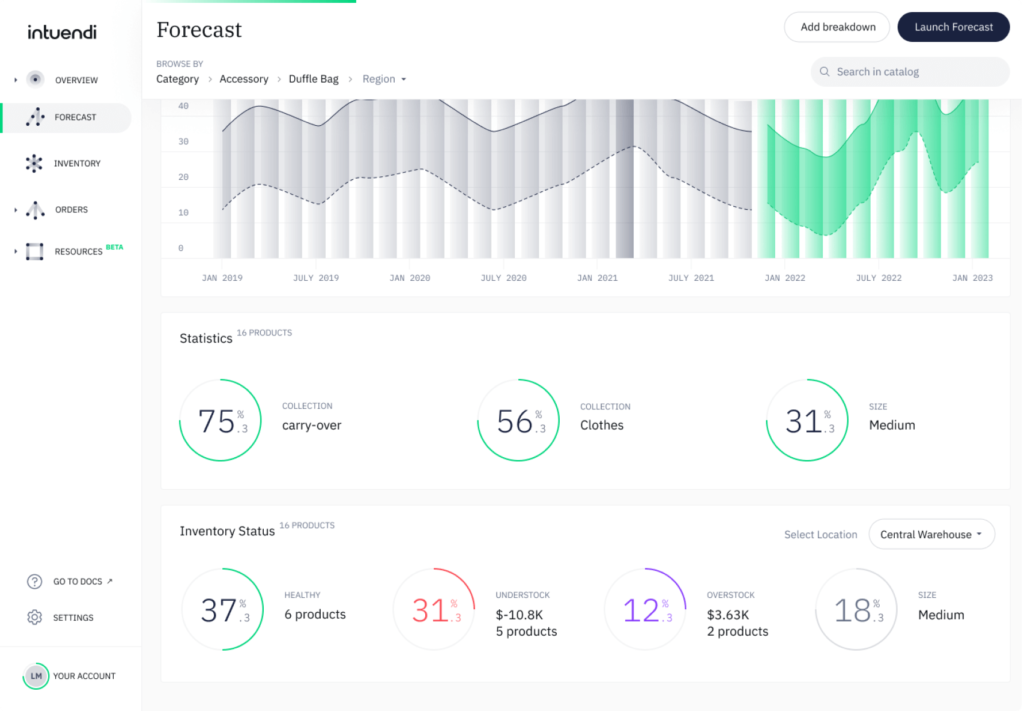It is imperative that businesses are able to constantly roll out inventory according to their customers’ needs and demands. Understanding your company’s cycle inventory needs has the power to bring about a more informed and thus planned and strengthened supply chain management strategy. This article will explore the ins and outs of cycle inventory, defining it, looking at the factors influencing it, and working out its calculation!
What is Cycle Inventory?
Cycle inventory is the stock that varies with the production cycle or order quantity. Companies will ensure that a specific amount of inventory and raw materials are kept in stock in order to respond to regular and expected sales and customer demand – this is the cycle inventory, the inventory needed for any specific cycle. Cycle inventory works within expected sales parameters and does not take into account any major fluctuations or causes of change in demand or sales that may occur.
Cycle inventory, however, does call for careful supply chain management efforts, as it can quickly tie up capital and bring about increased storage costs. However, when it is managed effectively, businesses are able to prevent stock-outs and maintain customer satisfaction! Businesses maintain cycle inventory to balance production costs and meeting customer demand. When stock is produced or ordered in larger quantities, businesses are able to maintain a consistent supply of these products to their customers, without running into any stock-out situations. They are additionally able to capitalise off of the sheer scale of inventory by reducing set-up costs, ultimately resulting in cost savings.
What are the Factors that Impact Cycle Inventory?
Demand
A higher or lower demand will directly impact the need for higher or lower inventory levels, driving businesses to adjust their production or ordering quantities accordingly. In periods of high demand, companies should place their focus on mitigating issues of stock-outs, thus calling for larger inventory batches to ensure product availability. Conversely, during periods of low demand, companies should be encouraged to lessen their production and ordering quantities so as to not find themselves in overstocking situations. Both instances can bring major, unnecessary costs if the supply chain is not managed effectively. Striking the right balance between demand variability and efficient inventory management is necessary for maintaining a responsive and cost-effective supply chain. Furthermore, it is of utmost importance that the demand planning and forecasting taking place before product purchasing and ordering is completed with immense accuracy.
Order Costs
Order costs are the costs associated with shipping, tracking, and holding inventory, and can have a weighty influence on the shaping of inventory cycle decisions. Generally, when order costs are higher, cycle inventory costs will have to adjust accordingly. However, to soften the blow of increased order prices, companies can choose to purchase or order inventory in larger quantities, as the cost is spread across a larger amount, thus reducing the overall cost per unit. However, finding the balance between larger orders with lower ordering costs whilst simultaneously avoiding overstocks and the costs associated thereof should be of utmost priority.
Lead Time
Lead time can be defined as the time that it takes from when a company has placed an inventory order to when the inventory order has been delivered. As one can imagine, lead time plays an integral role in cycle inventory management as it directly affects when businesses need to initiate the following order, without running into stock-out situations. Longer lead times are generally preferred over shorter lead times, as this allows for more time between orders, and thus lower and less frequent shipping costs. Lead time variability is an additional factor that needs to be taken into consideration, which is usually mitigated through the adoption of safety stock as an inventory buffer during periods of delays and unforeseen circumstances. Additionally, businesses can avoid any major issues of lead time variability through closely working with suppliers to reduce lead times, using technology for real-time tracking of shipments and inventory quantities, as well as improving demand forecasting accuracy.
Holding Costs
These represent the costs incurred for storing and maintaining inventory over time. These may include warehousing expenses, insurance, and the opportunity cost of holding inventory. Storing inventory requires physical space, which, in turn, requires storage costs, rent, utilities, maintenance, and salaries for warehouse workers. Furthermore, larger inventory quantities lead to higher warehousing expenses. Insurance against theft, damage, or natural disasters is a necessity in every business. However, great insurance does always come with a great cost, which are usually factored into holding costs. Opportunity cost is an important factor, as capital ties up in inventory could be invested elsewhere for potential returns. If the cycle inventory sells well, in accordance to the demand forecasted, then the opportunity costs have been well-spent. Businesses need to hold enough inventory to satisfy their customers’ needs, but not so much inventory that money is wasted on excessive holding costs.
Product Price
Product prices have a direct influence on order quantities and inventory holding costs, and thus, cycle inventory decisions. Similarly to higher order prices, businesses can take advantage of bulk purchasing when product prices are higher, so as to save on the cost per unit. Conversely, lower prices might prompt smaller order quantities to avoid typing up excess capital. The relationship between price and order quantity is impacted by factors such as the magnitude of price changes, carrying costs, and the trade-offs between cost savings and potential holding costs. Holding costs, particularly the opportunity cost component, are also affected by fluctuating product prices. With increasingly high product costs, businesses might be more inclined to minimise inventory levels in anticipation of higher returns from alternative investments.
Discounts
Oftentimes companies will be offered discounts for purchasing or ordering inventory in bulk or in larger quantities, ultimately resulting in a lower cycle inventory price and higher cycle inventory numbers. However, it is important that businesses take advantage of discounted prices in a structured manner, as they can run the risk of tying up capital and incurring increased holding costs.
What is the Difference between Cycle Stock and Other Inventory Types?
As previously explained, cycle stock is the stock kept for calculated and expected customer demand, not taking into account any major or dramatic changes that may occur in the market, ultimately affecting supply and demand. Any additional stock that is ordered or purchased to act as a buffer during these periods of change can be considered as safety stock. Safety stock acts as an insurance against unexpected demand spikes or supply chain disruptions. Another inventory type is pipeline inventory. Pipeline inventory refers to stock that a company has paid for and owns, but may not necessarily have in physical possession due to it still being in transit. Businesses utilise different forms of inventory to serve an efficient supply chain that meets customer demand and manages risks associated with production variability.

What are Examples of Cycle Inventory in Different Contexts?
Retail: Before the start of a new season, clothing retailers will typically order larger quantities of specific styles or designs that research has shown to be on trend to capitalise on cost savings from bulk purchasing. These items are then distributed to stores over the course of the season to meet varying customer demands, enabling the retailer to respond to changing preferences while reducing production costs.
Food and Beverage: These companies often produce their products in large batches to maximise efficiency. This inventory is then distributed to retailers, ensuring that the products are readily available to meet consumer demand while minimising production set-up costs.
Pharmaceuticals: Pharmaceutical companies use cycle inventory to produce and store larger quantities of medications with consistent demand to reduce manufacturing costs. These products are maintained in inventory to ensure a reliable supply for pharmacies and patients, avoiding stock-outs and disruptions in patient care.
How do you Calculate Inventory Cycle?
It is important to note that a company needs a list of certain numbers before it can calculate the inventory cycle. This list includes annual sales or demand, reordering costs, costs per unit, and storage costs. Once these numbers have been calculated, use the following formula to calculate cycle inventory. The order is the same as the Economic Order Quantity formula, which informs the ideal quantity of units a company should order or purchase:
Cycle inventory = √[(2 x D x S) / (C x I)] D = annual demand for the product S = fixed cost per unit C = unit cost I = storage cost per unit
Let us calculate cycle inventory in a working example:
A retail store sells electronic gadgets. The annual demand for a particular gadget is 1000 units, with a fixed cost per order being set as $200. The unit cost is $50 and the storage per unit is $5.
Step 1: Break it down
D = 1000 units S = $200 C = $50 I = $5
Step 2:
√[(2 x 1000 x $200) / ($50 x $5)] = 40 units (approximately)
Why Should Cycle Inventory be Used?
Fewer Sales Lost
By managing inventory levels in accordance with production and ordering cycles, businesses can ensure a consistent supply of products, ultimately minimizing the inventory risk of stock-outs and thus fewer sales lost. Backorders, often frustrating for customers, are also mitigated. Through consistently meeting customer demands and teaching customers to rely on your business to fulfil their needs promptly and reliably, they are more likely to return for future purchases and recommend your company to others.
Reduced Carrying Costs
Businesses should carefully balance their order quantities and inventory levels to avoid overstocking, as this can tie up capital and incur additional storage, insurance, and obsolescence costs, and understocking, resulting in frequent, costly replenishment orders and potential production disruptions.
Safety Stock Buffer
While safety stock is an essential component of inventory management, excessive safety stock can increase holding costs and lead to over-investment in inventory. By maintaining an appropriate cycle inventory that aligns with demand patterns and production cycles, businesses can manage variability more effectively, reducing the reliance on safety stock for demand fluctuations.
Decreased Production Downtime
By having sufficient inventory on hand, businesses can avoid disruptions in production caused by the unavailability of stock, required materials or components. A continuous flow of materials ensures that the manufacturing process can continue without disruptions, resulting in kept to production schedules and customer demands. The presence of cycle inventory as a buffer ensures smooth supply chain operations, reducing the risk of costly downtime and maintaining efficient production cycles.
How Does Cycle Inventory Fit into the Supply Chain Management Process?
Cycle inventory fosters a well-functioning supply chain when a harmonious equilibrium between cost efficiency and responsive inventory levels is achieved. By strategically calibrating production and ordering cycles, cycle inventory ensures a seamless flow of products, mitigating stock-outs or overstocking, and bolsters buyer confidence. Cycle inventory underpins smooth operations, fortifies supply chain resilience, and satisfies customer expectations.






